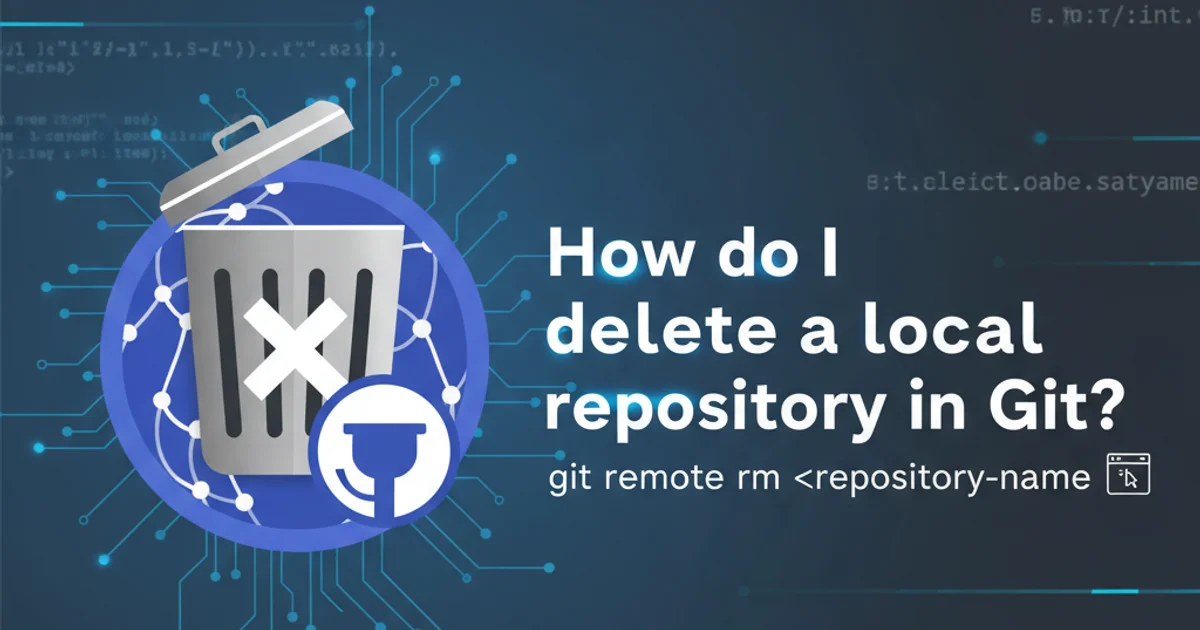How do I delete a local repository in Git?
Categories:
How to Delete a Local Git Repository

Learn the correct and safe methods to remove a local Git repository from your system, including considerations for remote connections and untracked files.
Deleting a local Git repository is a straightforward process, but it's important to understand what you're removing and the implications of doing so. This guide will walk you through the standard methods for safely deleting a local Git repository, ensuring you don't accidentally remove important files or configurations.
Understanding a Local Git Repository
A local Git repository is essentially a directory on your computer that contains your project files along with a hidden .git subdirectory. This .git directory is the heart of your repository; it stores all the version control information, including commit history, branches, tags, and remote configurations. When you delete a local repository, you are primarily concerned with removing this .git directory and, typically, the associated project files.
flowchart TD
A[Local Project Folder] --> B[.git Directory]
B --> C[Commit History]
B --> D[Branches]
B --> E[Remote Tracking]
A --> F[Working Directory Files]
F -- "Managed by" --> BStructure of a Local Git Repository
Method 1: Deleting the Entire Project Directory
The simplest and most common way to delete a local Git repository is to remove the entire project directory. This method ensures that all project files, including the .git directory, are completely removed from your system. This is suitable when you no longer need the project or its history locally.
1. Navigate to the Parent Directory
Open your terminal or command prompt and navigate to the directory that contains the repository you want to delete. For example, if your repository is my-project located in ~/Documents/projects/my-project, you would navigate to ~/Documents/projects.
2. Remove the Directory
Use the appropriate command for your operating system to recursively delete the project directory. Be extremely careful with this command, as it permanently removes files.
Linux / macOS
rm -rf my-project
Windows (Command Prompt)
rmdir /s /q my-project
Windows (PowerShell)
Remove-Item -Recurse -Force my-project
rm -rf (Linux/macOS) and rmdir /s /q (Windows) commands are powerful and do not send files to the recycle bin. Ensure you are in the correct directory and targeting the correct repository before executing them.Method 2: Deleting Only the .git Directory
If you want to keep the project files but remove all Git version control history, essentially turning the directory back into a regular folder, you can delete only the .git directory. This is useful if you want to re-initialize a new Git repository in the same folder or simply discard the version history while retaining the code.
1. Navigate into the Repository
Open your terminal or command prompt and navigate directly into the root of the Git repository you wish to modify. For example, cd ~/Documents/projects/my-project.
2. Remove the .git Directory
Use the appropriate command to recursively delete the hidden .git directory. After this, your project directory will no longer be a Git repository.
Linux / macOS
rm -rf .git
Windows (Command Prompt)
rmdir /s /q .git
Windows (PowerShell)
Remove-Item -Recurse -Force .git
.git directory, you can re-initialize a new Git repository in the same folder by running git init.What About Remote Repositories?
Deleting a local Git repository does not affect any remote repositories (e.g., on GitHub, GitLab, Bitbucket) that it might have been connected to. The remote repository will remain untouched. If you also wish to delete the remote repository, you must do so through the interface of the respective hosting service.
sequenceDiagram
actor User
participant LocalRepo as Local Repository
participant RemoteRepo as Remote Repository (GitHub/GitLab)
User->>LocalRepo: Delete local folder (rm -rf)
LocalRepo-->>User: Local files and .git removed
Note over LocalRepo,RemoteRepo: No direct interaction between deletion and remote
User->>RemoteRepo: (Optional) Manually delete remote repo via web UI
RemoteRepo-->>User: Remote repository deletedImpact of Local Repository Deletion on Remote Repositories